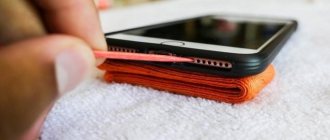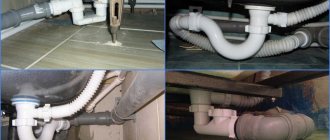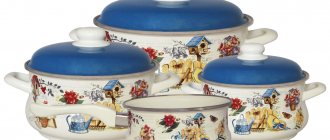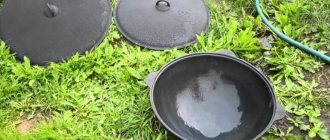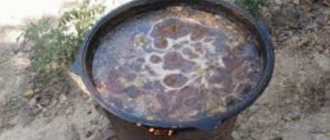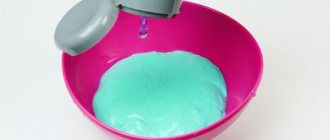Irons with a steam extraction function have the only drawback - they require the use of distilled water. Even filling the tank once with tap water can lead to scale or mold. If this happens, for cleaning the iron from the greens in the tank at home.
If you are interested in an article on the topic - how to clean the iron from scale inside the Philips, read our next article.
How bleach never stops working - grandma's proven remedy
The presence of mold in a water tank is indicated by stains on the fabric surface in a characteristic brown, gray or green color. If this is the case, then you can try to get rid of it using bleach. The product has the ability to react with mold spores, cleaning and protecting the surface from further formations.
It is worth noting that the use of bleach will only become practical at the initial stage of infection, before new spore formations penetrate deep into the surface of the tank. Bleach is an aggressive substance with a characteristic odor, so you should never ignore the stage of finishing the tank with drinking water (you cannot use ammonia due to the formation of toxic gases).
Before you clean
prevent mold from forming in the water container in the iron, open windows and vents in the room, and protect your hands with gloves.
To prepare the solution, mix bleach with water in a ratio of 1:10. The resulting product is poured into the tank and left for some time, after which the steam function is turned on and the mold particles are released simultaneously with the solution through the holes. The last step is to rinse the tank with distilled water.
Features of internal cleaning
Brown liquid flows out of the iron
If the iron spits rust, this may be due to the internal elements of the silicone steam generator becoming unusable. These parts are gaskets between the water tank and the base of the device.
- During prolonged use, the sole becomes hot. At the right time, the thermostat, which turns off the iron to prevent excessive overheating, does not work.
- The metal heats up to such an extent that it begins to affect the insulation of the silicone steam generator chamber.
- At a heating surface temperature of about 300 degrees, even heat-resistant silicone material melts.
- The iron begins to spit out brownish liquid. This is not rust, but molten silicone, similar in color to it.
It is necessary to replace a thermostat that has stopped working. The new unit will allow you to get rid of excessive overheating of the metal elements of the iron. If this is not done, the device may become unusable.
Real rust occurs not only due to poor quality water, but also due to a violation of the insulation of metal elements from moisture inside the steam generator chamber. If they are corroded, there is no point in repairing the device. If it’s just a matter of rusty or moldy stains due to bad water, the iron can be used quite well after proper cleaning.
How to get rid of mold using borax
To clean the iron
for algae - the result of stagnant water from the tap, borax is suitable. This completely natural product does not contain chemicals, does not emit toxins, is suitable for cleaning drains and bathrooms, and can be used as an insecticidal agent in the fight against mold.
To remove mold from the iron reservoir you need:
- mix borax with water (a glass of the product per 2.5 liters of water);
- prepare a stiff brush;
- fill the reservoir with solution, clean it with a brush;
- Rinse off any remaining product with clean distilled water.
One rinse will be enough to remove excess solution. Residues of the product on the surface of the tank should be left, they can interfere with the growth of bacteria.
If you are interested in an article on the topic of how to descale an iron at home, read our next article.
Household chemicals
Anti-scale agent for irons Un Momento, super concentrate
If brownish or whitish stains appear on the sole, which differ from ordinary burnt marks, you can use Anti-scale. The process is simple. Following the instructions, dilute the product in water, then pour it into a container and heat the iron strongly. Turn it off and wait about 30 minutes. Drain the contaminated liquid and clean the container with clean water.
German-made compounds containing organic acids and anti-rust components also help: Topperr, Bosch, Filtero 605.
To clean the iron from rust inside with such preparations, follow this procedure:
- Dissolve the product in water in a ratio of 3:1.
- Preheat the iron by setting the control to maximum, and then turn it off.
- Pour the composition into the water inlet, place the device horizontally and wait 2 hours.
- Pour out the product and rinse the inside a couple of times with water.
Immediately before ironing, check the cleanliness of the appliance by releasing steam.
The drug “Silit” perfectly removes corrosion and scale. To clean the iron, you need to turn it upside down and carefully pour the cleaning agent drop by drop into the sole holes. After a few minutes, traces of rust will appear on the outside. Remove them with a dry cloth, then add water, and press the steam release buttons several times.
Vinegar against mold - how effective it is
When the water in the iron has bloomed, vinegar essence can also help out. Both in pure and diluted form, vinegar makes it possible to get rid of 80% of types of bacteria. Real distilled vinegar is suitable for finishing. The advantages of the product include:
- effectiveness;
- naturalness;
- attractive price;
- ease of use.
The cleaning process is not difficult at all. Vinegar, concentrated or diluted, is poured into a water container and left for an hour or two, depending on the degree of contamination. After this time, connect the steam function, releasing the solution simultaneously with the remains of mold. After finishing, the tank is washed again with drinking water.
Causes of blockage
A dirty iron can be a serious obstacle to getting your clothes ironed. Steam stops coming out, scale appears, stains remain on things after ironing - this is just an incomplete list of what happens due to the appearance of dirt.
- Unfiltered tap water causes scale to form inside the iron. This prevents you from fully using the steaming or wetting function.
- Yellow stains appear on your clothes if salts have begun to deposit on the heating element.
- Too high a temperature when ironing leads to the formation of carbon deposits on the sole. It, in turn, is transferred to clothing.
- Long-term contact of a hot iron with synthetic fibers.
- Contact of substances with resin or glue on a hot sole leads to contamination of the sole.
Using a dirty iron for its intended purpose is dangerous for both clothing and electrical appliances. If you notice any problems, turn off the iron and start taking action.
Mold and ammonia - how they interact
Just like the bleach described above, ammonia helps remove mold on the surface. Being a chemical substance, after finishing alcohol is washed off with distilled water, without adding bleach under any circumstances.
You can achieve the effect by mixing alcohol with water and filling the iron reservoir with it for a couple of hours. The steam removal function will allow you to free yourself from the solution. With its help it will be possible to further clean
holes on the sole.
Anti-corrosion care for irons
Like any household appliance, the iron requires protection against internal contamination. Then its service life will increase, and the laundry will not become dirty when ironing.
Follow these recommendations:
- do not iron synthetics at maximum temperature;
- monitor the quality of the water used;
- Always drain the container after ironing.
Do not use only distilled water for ironing. Its boiling point is higher, vaporization is worse, which can cause damage to the internal walls of the device. It is better to choose boiled. Hard water is mixed with distilled water in equal parts.
If rust marks appear on ironed laundry, it is worth disassembling the device. Perhaps the problem is the melting of silicone parts or corrosion of metal parts. In order not to aggravate the situation by cleaning, it is worth carrying out a preventive check and, if necessary, sending the iron for repair.
Irons with a steam extraction function have one drawback - they require the use of distilled water. Even filling the tank with tap water once can lead to the appearance of scale or mold. If this happens, then you can clean the iron from the greens in the tank at home in several ways.
Hydrogen peroxide and baking soda are common ways to combat mold.
When it is necessary to clean a container of water from mold, hydrogen peroxide will help remove green deposits from the bottom and walls, providing protection from new formations in the future. The antifungal agent will cope perfectly with mold, is safe, and has no toxins.
If you are interested in an article on the topic of how to clean a ceramic iron from burnt marks on the sole at home, read our next article.
Removing mold with peroxide is easy. To do this, pour it into a container for no more than ten minutes, speed up the process with a narrow, hard brush.
A common and safe remedy is baking soda. The product is safe, does not release toxins, has a gentle effect on the walls of the tank, delicately removing traces of mold. The advantage of this method is the ability of soda to absorb moisture, which prevents the formation of bacteria in the future. To cleanse, soda is mixed with water at the rate of ? tablespoon per glass of distilled water.
Tea tree oil is a safe method for removing mold
A non-standard option that allows you to get rid of mold in the iron tank is tea tree oil. Unlike all the remedies described above, oil is not cheap. A few drops are enough to remove mold. Antifungal and antibacterial, the oil is mixed with water (a teaspoon per glass of water) and added to the iron container. The final step is to remove the liquid through the steam holes.
Tap water is full of various impurities. They negatively affect the operation of steam generators and irons. Because of this, scale and rust form inside the device, which reduces the quality of ironing and damages the fabric. If the steam system is rarely used, the water tank may become moldy and green on the inside. It is important to know how to clean an iron from mold, rust and scale in order to extend its working life and avoid damage to fabrics.
Embedded Systems
Most iron models are equipped with built-in self-cleaning functions and anti-limescale systems.
Self-cleaning function from scale and rust
Perform the operation at least once every 2 months:
- prepare a container to drain dirty liquid from the iron;
- fill the tank with water;
- turn on the household appliance at full power, wait until it turns off automatically. Turn the device back on;
- When the iron turns off, place it in a horizontal position over your pelvis.
- press the self-cleaning button (“Calc Clean”): at the same time, steam with particles of plaque, rust and other contaminants will begin to emerge from the sole of the device;
- repeat the entire procedure 3-4 more times (until the device is completely clean);
- wait for the iron to cool completely, remove any remaining scale from the soleplate and the holes on it.
IMPORTANT! After self-cleaning, perform the first ironing on the old item.
Cleaning the bottom from carbon deposits
Soot formation on the sole is the most common problem
The formation of carbon deposits on an iron is a problem well known to every housewife. It is enough to make a slight mistake with the temperature, and the fibers of the fabric begin to stick to the sole, which is why a dark coating forms on it. Fortunately, there are effective ways to clean carbon deposits from your iron. For this purpose, you can use both chemical and home remedies that can be found in every home.
Let us immediately note that products such as a pencil (crayon), vinegar, lemon juice, ammonia, nail polish remover and hydrogen peroxide can be used to remove carbon deposits from soles made of any material (steel, aluminum, Teflon, ceramic, metal-ceramic and glass-ceramic). Toothpaste, soda and salt can only be used for metal coating. These are not the best options for cleaning expensive modern irons from carbon deposits. After all, if defects even invisible to your eye appear on their soles, the device will deteriorate. The fabric will increasingly stick to the iron or even melt.
Using a pencil
A universal pencil suitable for removing any dirt
A relatively cheap and convenient means for cleaning the soleplate of an iron is a pencil (also called “chalk”). During its use, a strong specific odor appears. Therefore, cleaning should be done in a well-ventilated area. Now we'll tell you how to use chalk:
- First, turn on the iron at maximum power and wait until it heats up well.
- Take a pencil and move it over the dirty areas of the sole. If the sole is heated, the crayon will melt upon contact with it. Try not to press too hard on the pencil, otherwise pieces of the product may break off and get into the holes.
- Run the iron over the unwanted rough fabric. This will help remove any remaining product from the surface of the sole.
The advantage of this cleaning method is that the pencil can be used on any type of finish. You should pay attention to the recommendations, since different crayons are suitable for different coatings (metal, Teflon or ceramic).
Cleaning with vinegar
A solution of vinegar and water will help remove carbon deposits from a smooth surface.
Cleaning soles with a smooth surface can also be done using ordinary table vinegar. Let us describe the sequence of actions:
- Dissolve 2 tablespoons of vinegar in a glass of water.
- Turn on the iron, wait until it warms up a little (not to maximum temperature).
- Dampen a cloth, sponge or cotton swab in the resulting solution.
- Wipe the carbon deposits until they disappear.
- If the holes in the sole are clogged with carbon deposits, clean them using a toothpick soaked in a vinegar solution and wrapped in a small piece of cotton wool.
Useful information: Remember that during cleaning the vinegar will heat up and you will have to breathe in its fumes. Therefore, you should not bring the iron on close to your face. Ideally, you should wear a gauze bandage that will protect the respiratory system.
Lemon juice and ammonia
Another popular home remedy for descaling is a mixture of lemon juice and ammonia. When preparing it, it is important to maintain the correct proportions.
40 milliliters of freshly squeezed lemon juice must be mixed with 10 drops of ammonia. Having done this, soak a swab in the resulting solution and wipe off the carbon deposits from the slightly warm sole. These ingredients work very effectively, allowing you to remove burnt marks from the surface of the iron in a matter of seconds.
Laundry soap
Laundry soap will help remove fresh dirt
To remove fresh dirt, you can also use regular laundry soap. Moisten the block, rub the sole well with it, then remove the foam and carbon deposits with a damp cloth. Unfortunately, it will not be possible to get rid of old stains this way.
Nail polish remover
If you accidentally ironed polyethylene (for example, a bag) and the material stuck to the sole, use the most accessible chemical solvent - nail polish remover - to remove it. This remedy can be found in every woman’s home.
It is enough to simply moisten a cotton swab or a small piece of cloth in a solvent and wipe off the remaining stuck polyethylene with it. After this, no traces will remain on the surface.
Hydrogen peroxide
Hydrogen peroxide (or its solid analogue - hydroperite tablets) is also used to remove carbon deposits in everyday life.
Useful information: If the contamination is significant, slightly heat the soleplate of the iron and run hydroperite over it. Then remove any remaining burnt residue with a damp cloth. Minor stains can be removed with a cotton swab soaked in hydrogen peroxide.
Toothpaste
Toothpaste is an effective cleaning agent
It is known that toothpaste can be used to remove a huge range of stains. It is also suitable for cleaning the soleplate of the iron from burnt fabric.
Squeeze a small amount of paste onto a slightly heated sole and rub it with a soft brush. After 3-4 minutes, wipe off any remaining product from the surface with a sponge soaked in warm water.
Soda
To remove the oldest and most stubborn traces of carbon deposits, you can use a paste of baking soda mixed with water or dishwashing detergent. This method does not require heating the soleplate, so the possibility of the formation of foul-smelling steam is eliminated.
Unfortunately, baking soda can ruin delicate finishes. In other words, after cleaning there will be micro-scratches on it that are invisible to the naked eye. In the future, this may lead to damage to the device. Therefore, it is not recommended to use soda to remove carbon deposits from ceramic or Teflon soles.
Salt
Salt should be used only as a last resort when other methods have proven ineffective. The fact is that it leaves micro-scratches on the sole.
- Prepare 2 cups of finely ground salt.
- Pour them onto newspaper or a scrap piece of clean cloth.
- Run a heated iron over the surface several times, as if ironing it. Do not put too much pressure on the iron, which has a steam function. Otherwise, small holes in the sole may become clogged with salt.
- Wipe the sole with a damp sponge. If necessary, repeat the cleaning procedure again.
Salt
If you have it, take sea salt - it absorbs any dirt faster. And at the same time it is an excellent natural antiseptic - it will also serve as disinfection. Just take salt without dyes, flavors or additives. You will need:
A thick sheet of paper and a spoon of salt.
What to do:
Drain all the water from the iron, turn off the steam and heat it at maximum power. Spread a spoonful of coarse salt in an even layer on an old pillowcase or thick paper sheet. Iron it back and forth several times and the burn will go away on its own. The main thing is not to press too hard so as not to scratch the surface of the sole on the salt crystals.
Removing rust at home
Antiscale will help get rid of rusty plaque
It happens that when ironing, a rusty coating appears on things. Most often, its formation is caused by pouring cold tap water into the liquid reservoir, which contains iron and other harmful impurities. When using distilled water, rust does not form. But what to do if it does appear?
- Mix half a teaspoon of Anti-Scalp with 200 milliliters of water.
- Pour the solution into the water container in the iron.
- Leave for about 40 minutes.
- After this time, rinse the tank. Rust stains will no longer bother you.
This method is suitable for irons with any type of coating.
Toothpaste
Toothpaste is a fairly effective, but at the same time delicate, iron cleaner. As in the case of salt, the simplest and most budget-friendly one without additives, dyes and flavors is better. You will need:
A drop of toothpaste.
What to do:
Just a little paste is all you need - you need to apply it in a thin layer over the soleplate of the iron. Rub the dirtiest areas a little separately and leave everything for 5-10 minutes until the paste eats away the burnt marks and plaque. Wipe the surface and iron the unnecessary rag a couple of times for final cleaning.
What to do if your water tank blooms?
Housewives often encounter such a phenomenon as contamination of the water tank in the iron. You can make an effective solution from 30 g. citric acid and 500 ml of warm water. Fill the reservoir with liquid for 2-3 hours. After the time has passed, rinse the container with water. For further use, fill the tank with, preferably, distilled water.
Adviсe
A few tips from experienced housewives will help solve the scale problem as quickly as possible:
- If you use softened water (ordinary tap water, boiled for ten minutes with a small amount of baking soda), you will have to clean the iron less often.
- The cleanliness of the anti-lime rod must be checked at least once every month and a half.
- You can avoid the rapid appearance of scale deposits by pouring distilled water into the iron (sold at any gas station).
- After cleaning with acetone, the device is tested on unwanted clothing. This will help prevent yellow marks from appearing during the ironing process.
The more often cleaning is carried out, the longer the life of the household appliance will be.
Find out more about ways to remove scale from household appliances here.

